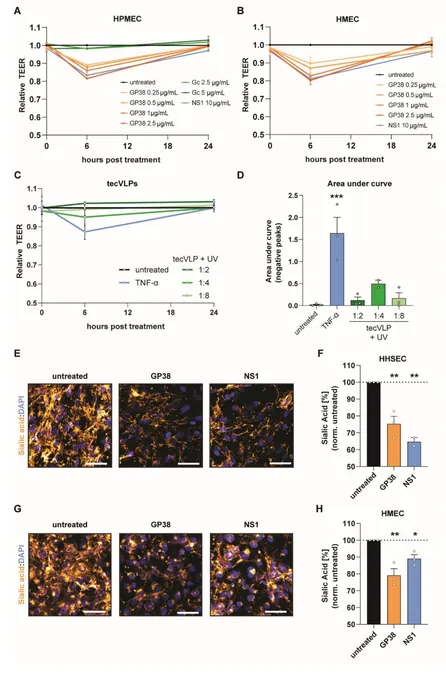
Breaking Ground: How the Glycoprotein GP38 from CCHF Virus Paves the Way for Monoclonal Antibody Treatments
2025-04-08
Author: Li
Introduction
In a groundbreaking study published in *Science Translational Medicine*, an international team of researchers, including experts from the U.S. Army Medical Research Institute of Infectious Diseases, the Albert Einstein College of Medicine, and the University of California-Berkeley, has uncovered critical insights into the Crimean-Congo hemorrhagic fever virus (CCHFV) and its glycoprotein GP38.
CCHFV Background
CCHFV poses a severe health risk, being endemic to various regions, including Africa, the Balkans, the Middle East, and Asia, and it is deemed a top priority pathogen by the World Health Organization. Transmitted primarily by ticks and livestock, CCHFV can lead to a staggering case fatality rate as high as 40%, with no approved vaccines currently available. The urgency for effective treatments could not be clearer.
Role of GP38 in CCHFV Infections
GP38 has emerged as a key molecular target for vaccine and therapeutic development due to its potential role in viral pathogenesis. However, until now, a significant gap in our understanding of GP38's function during infection has stunted progress toward developing effective medical countermeasures against CCHFV.
Research Findings
The new research reveals how GP38 acts as a ‘viral toxin,’ directly contributing to vascular leakage during CCHFV infections. "This study demonstrates that GP38 alone can trigger vascular leakage, which is crucial in understanding the pathogenesis of the virus," stated Andrew Herbert, a senior author and the branch chief at USAMRIID. This breakthrough suggests that GP38-specific antibodies could mediate critical protective effects during infection.
Exogenous GP38 and Vascular Leakage
Adding to the compelling evidence, experiments demonstrated that the introduction of exogenous GP38 exacerbates vascular leakage in CCHFV-infected mice, reinforcing the idea of GP38 as a secreted viral toxin. The implications of this finding are huge, suggesting that future CCHFV vaccines should prioritize GP38 as a central component.
Monoclonal Antibodies and Protection
A previous study from July 2024, led by Monticelli and Herbert, identified a wide range of GP38-targeting monoclonal antibodies (mAbs) from humans who survived natural infections. These mAbs showed potential in protecting laboratory animals against diverse CCHFV strains. However, the mechanism behind their protective efficacy remained unclear—until now.
"Understanding how these antibodies mediate protection is pivotal for developing effective treatments," elucidated Stephanie Monticelli, a co-first author and a research scientist at USAMRIID. The latest findings indicate that non-neutralizing GP38-specific mAbs that focus on the N-terminal region of GP38 provide the most robust protection against lethal challenges, reducing circulating GP38 levels and vascular leak, while also limiting the virus's spread to other tissues.
Conclusion
Interestingly, the study found that the effect of a neutralizing mAb targeting another viral protein was far less potent, prompting researchers to conclude that the beneficial effects of GP38-binding mAbs arise not only from decreasing viral loads but also from specifically blocking GP38’s harmful functions.
As we grapple with complex virus-host interactions that complicate viral infections, the study reinforces the significance of understanding how viral proteins can perform multiple roles, often collaborating with both host and other viral proteins to ensure the virus's survival.
This research is a vital component of the Prepositioning Optimized Strategies for Vaccines and Immunotherapeutics Against Diverse Emerging Infectious Threats (PROVIDENT) consortium, which aims to bolster the fight against emerging infectious diseases.
The implications of this research are profound, opening new pathways for the design of effective vaccines and therapies to combat the deadly Crimean-Congo hemorrhagic fever virus. The clock is ticking, and the health of countless lives hinges on such scientific breakthroughs!



 Brasil (PT)
Brasil (PT)
 Canada (EN)
Canada (EN)
 Chile (ES)
Chile (ES)
 Česko (CS)
Česko (CS)
 대한민국 (KO)
대한민국 (KO)
 España (ES)
España (ES)
 France (FR)
France (FR)
 Hong Kong (EN)
Hong Kong (EN)
 Italia (IT)
Italia (IT)
 日本 (JA)
日本 (JA)
 Magyarország (HU)
Magyarország (HU)
 Norge (NO)
Norge (NO)
 Polska (PL)
Polska (PL)
 Schweiz (DE)
Schweiz (DE)
 Singapore (EN)
Singapore (EN)
 Sverige (SV)
Sverige (SV)
 Suomi (FI)
Suomi (FI)
 Türkiye (TR)
Türkiye (TR)
 الإمارات العربية المتحدة (AR)
الإمارات العربية المتحدة (AR)